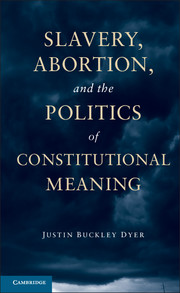Book contents
- Frontmatter
- Contents
- Acknowledgments
- Preface
- 1 The Conscience of a Nation
- 2 Substance, Procedure, and Fourteenth Amendment Rights
- 3 Dred Scott, Lochner, and the New Abortion Liberty
- 4 Constitutional Disharmony after Roe
- 5 The Politics of Abortion History
- 6 Private Morality, Public Reasons
- 7 Personhood and the Ethics of Life
- Index
- References
4 - Constitutional Disharmony after Roe
Published online by Cambridge University Press: 05 April 2013
- Frontmatter
- Contents
- Acknowledgments
- Preface
- 1 The Conscience of a Nation
- 2 Substance, Procedure, and Fourteenth Amendment Rights
- 3 Dred Scott, Lochner, and the New Abortion Liberty
- 4 Constitutional Disharmony after Roe
- 5 The Politics of Abortion History
- 6 Private Morality, Public Reasons
- 7 Personhood and the Ethics of Life
- Index
- References
Summary
As the late Samuel Huntington noted in his seminal work on American political development, “an ever-present gap exists between American political ideals and American political institutions and practice.” If we understand a constitution as the fundamental norms, principles, and practices of a particular society (including the scheme of distributing political power), we might characterize the gap or tension between ideals and practice as a kind of constitutional disharmony. In the American context, Huntington argued, such disharmony has been particularly acute because of the “central role of moral passion” in American politics, which has given rise to myriad reform movements that appeal to foundational moral principles such as those prominently featured in the preamble to the Declaration of Independence. The classic example of disharmony, along these lines, was occasioned by the institution of slavery, which created convulsions in the polity precisely because slavery was inconsistent with the normative principles underlying the regime.
As Jennifer Hochschild writes, the American system of race-based, hereditary chattel slavery was “antiliberal in its assertion of the unequal worth of persons, of civil – not natural – determinations of rights, of the legitimacy of denying liberty and opportunity to some.” Of course, scholars still debate the best way to conceptualize the relationship between slavery and the principles of American government. One answer to the question of how slavery could co-exist with a political culture that emphasized liberty and individual rights is that slavery was simply an aberration. Another possible explanation, however, is that rights-oriented liberalism and racial slavery were actually symbiotic. A version of the symbiosis argument was prominently put forward by Edmund Morgan in his study of slavery in eighteenth-century Virginia. What made freedom and equality among the Virginia elites possible was the relative equality of leisure and economic resources provided by the system of forced labor.
- Type
- Chapter
- Information
- Publisher: Cambridge University PressPrint publication year: 2013

